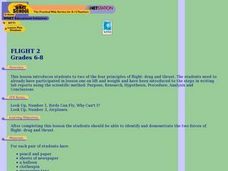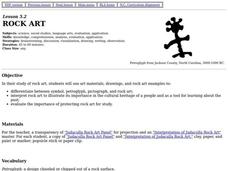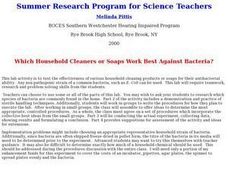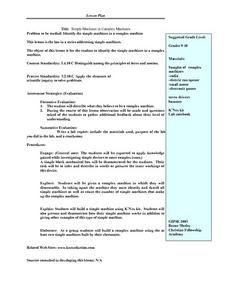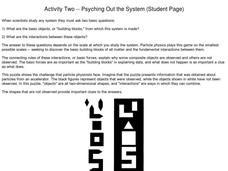Curated OER
Scientific Inquiry Post-Test
In this scientific inquiry post-test worksheet, students complete a 7 question matching activity that uses vocabulary associated with the inquiry process. They answer 2 multiple choice questions about independent and dependent variables.
Curated OER
How Does a Thermometer Work?
Students explore how a thermometer works. In this temperature lesson, students use a glass bottle, a straw, and food coloring to construct a homemade thermometer. Students record observations.
Curated OER
How Can They Tell?
Pupils compare the characteristics of arcade tokens to those of a circulating U.S. quarter to determine how a video game can tell the difference between the two. They examine coins and arcade tokens very closely to observe the differences.
Curated OER
We're Batty
Pupils watch a video about bats and compare and contrast them to birds. They identify the specific characteristics that identify bats as mammals and what makes them unique from other mammals.
Curated OER
Flight 2
Students are introduced to two of the four principles of flight: drag and thrust. As the class watches a video on these principles, they utilize ballons, straws and clothepins to simulate what they're seeing in the show. Nice, hands-on...
Curated OER
What are the Chemical and Microbiological Effects of Run-off from a Catfish Pond on the Surrounding Soil and Water?
Students study data from a USDA catfish pond. They look for microbial populations and chemical concentrations in the runoff to determine the effectiveness of filter strips. They use their knowledge of biogeochemical cycles to explain the...
Curated OER
Insect Travel Brochure
Seventh graders study producers and consumers in habitats. They examine the trophic levels and how different organisms interact with a focus on insects. They create a travel brochure for an insect to visit a habitat which they create.
Curated OER
Rock Art
Fourth graders examine and interpret rock art to illustrate its importance in the cultural heritage of a people and as a tool for learning about the past. They create their own rock art that is a symbol of their culture.
Curated OER
Water Pollution Experiments
Fifth graders conduct experiments in simulated water pollution using a box of items to hold "pollutants"and an aquarium, representing a waterway. They observe how "rain" from a watering can poured into the box washes the pollutants into...
Curated OER
Which Household Cleaners or Soaps Work Best Against Bacteria?
Young scholars experiment to determine the efficacy of various household cleaning products and soaps as antibacterial agents. They work in groups to complete this four part lesson series which includes identifying household bacteria,...
Curated OER
Activities of the Immune System (Activity 1)
Students cut an apple in half and cover half with plastic wrap. They place drops of liquid on each half and discover how our skin protects us. They answer discussion questions to end the lesson.
Curated OER
What Do Monarch Caterpillars Eat?
Students use the scientific method to discover what monarch caterpillars eat. They observe the caterpillars for 2 minutes at a time and make observations.
Curated OER
What Do Monarch Caterpillars Eat?
Learners record and analyze what types of food monarch caterpillars will eat.
Curated OER
Investigating Ocean Life
Sixth graders explore the various forms of ocean life. They research a creature that lives in the ocean. Students use their research information to create a series of HyperStudio stacks about their sea creature.
Curated OER
Critical Reading- Air Pollution and Asthma
Students read two different articles which present the scientific issue of asthma, the causes, and the rising rates in our society. Students read for facts and examine whether or not the scientists have a political point of view....
Curated OER
Biodiversity
Students match certain animals with a possible fate that could happen to them from a provided list in order to discover the threats to biodiversity and the role humans play. They also discover the importance of biodiversity and what we...
Curated OER
Simple Machines In Complex Machines
Pupils brainstorm the concept of a machine. They make lists of the characteristics that all machines share. The teacher uses questioning in order to get students to think more deeply about the subject. They create a lab to demonstrate...
Curated OER
Modeling Mendel's Pea Experiment
Young scholars discover what Mendel uncovered in his famous pea experiments. They form explanations for the result of crossing a true-breeding round pea plant with a true-breeding wrinkled pea plant (the F1 generation) and for the...
Curated OER
Vector Manipulation Unit
Students are introduced to the concept/idea of a vector, what it represents and why they are used. They develop an understanding of what vectors are, how and why they are used.
Curated OER
The Environment and Interactions of Living Organisms
Young scholars study the environment and interactions of living organisms. They identify abiotic and biotic factors and create a foldable and vocabulary cards. They create a poster illustrating soil and watch a video to study symbiosis.
Curated OER
Scales, Scutes, and Skins
Students identify the various adaptations of reptiles and amphibians. After distinguishing between reptiles and amphibians, students discuss the ways in which their adaptations aid in their survival. They participate in a hands on...
Curated OER
The Water Cycle
Students list the nine places on earth where water is found. They define the terms cycle and water cycle. Students explain how energy from the sun powers the movement of water molecules through the water cycle. They name and describe...
Curated OER
Activity Two--Psyching Out the System (Student Page) Asking Questions, Using Clues
Students observe two-dimensional shapes and work on the challenge that what is observed is as important as what is not observed.
Students determine constructions, rules and connections.
Full references listed for further reading and...
Curated OER
A Tall Ship and a Star to Steer Her By
Students create a water transportation device powered by wind. In this wind power instructional activity, students research transportation concepts after reading the poem "Sea Fever" by John Masefield. Students design the fastest...




